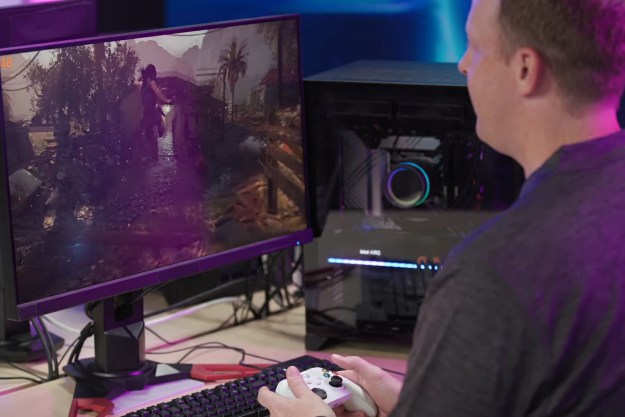
Last week, I shared some of the cool demonstrations I saw at Nvidia’s massive GPU Technology Conference – an impressive showing by the most powerful technology company in the graphics segment. But not the only one. This week, AMD stepped up with a plan to convert one of its biggest weaknesses into a significant strength. On top of this, both companies are chasing the cloud opportunity, which could invalidate all traditional approaches to high-performance gaming along with bypassing most of the limitations.
Let’s explore the different strategies from AMD and Nvidia this week, and the impact of the growing focus on cloud gaming.
Nvidia’s mobile-hinged strategy
The most important part of Nvidia’s presentation was the announcement that the company would bring the Cuda processing platform from computers to tablets and smartphones by the end of 2015. This is currently the fastest growing gaming segment. If Nvidia gains a foothold for Cuda on mobile hardware with this move, developers will be able to cheaply and easily shuttle games between mobile and PC platforms. Building for Cuda would potentially give them huge economies of scale, providing the financial incentive to favor Nvidia over other platforms.
However, currently Nvidia, while a major player, doesn’t dominate mobile. Apple holds that position, thanks to the iPad. With targeted a 2015 release for Cuda in a market measured in 100s of millions, it could take years to reach critical mass. So to be successful, Nvidia will either need to get Apple, Samsung and Amazon on board, or substantially eclipse their products. No matter what, the gaming experience will need to be consistent enough across mobile devices to entice developers with the ability to develop once for many devices.
AMD’s game console strategy
AMD wants to dominate the console gaming market. Because games are often developed to run on at least two of the consoles and the PC platform, pulling this off should give the company an early advantage. Consoles and PCs are generally pretty close in performance, and that means the advantages are more easily achieved near term.
While AMD’s financial position isn’t as strong as Nvidia’s, that actually turns out to be an unexpected advantage. This is because the console business is a very low-margin business; the devices are sold at or below cost. That has made it unattractive to high-margin companies like Intel and Nvidia because financial analysts would punish them for the adverse impact on their margins, were they to again pick it up. But AMD has already been punished, so making this move is relatively low risk for it. If the move pays off, it will have a huge benefit in the higher margin PC space, because games developed for AMD hardware in a console should be easier to move to AMD hardware on PCs.
However, the game-console market isn’t what it once was. Nintendo is clearly having issues staying relevant this year, Sony is far off its PlayStation 2 highs, and Microsoft appears to be putting more effort into media distribution right now than gaming. Coupled with the growth of gaming on mobile, the console market isn’t as strong as it needs to be to drive AMD’s strategy to success. But AMD hardware powering consoles could potentially solve its own problem by reducing the cost of making console games, making them more attractive to developers. The glut of mobile games has made it hard to make a profit there, too, possibly making consoles more attractive. One final advantage is that the game console makers don’t switch partners as often as PC or mobile-device makers. That makes AMD’s move stronger, because the fate of AMD and the console folks are more closely tied, but only if consoles recover a substantial amount of their lost power.
Cloud gaming
Both AMD and Nvidia are putting a lot of effort into cloud gaming. Nvidia had two cloud-gaming companies at its event and AMD had one, but the whole market is still in its infancy. We are far from naming any provider a winner, particularly given that big players like Microsoft, Google, Amazon, and most of the cable and telephone companies have yet to enter or pick a dance partner for this space.
Cloud gaming could make the power in a console or PC irrelevant, because the processing is done on remote hardware. That means the game console could be a smart TV, cable box, PC, tablet, or smartphone, and you can develop one version of the game to play on all devices. Basically, the territory both AMD and Nvidia are playing for could basically evaporate if we all move to cloud gaming, which is likely within 10 years.
To get there, we have to solve a number of nagging problems like bandwidth availability, cost, and network latency. Still, year-over-year progress is pretty amazing, largely due to the increasing need to do VoIP (Skype) calls and watch Internet videos. Most of us could be legitimately playing this way from our homes by the end of the decade.
The advantages remain low cost, ability to seamlessly move from device to device often without losing state (you start on the new device exactly where you left off in the old one) and an appliance experience (the stuff just works), all of which are pretty compelling.
Who wins?
In terms of strategy, whichever company can leverage its near-term advantages into cloud-gaming dominance wins.
AMD has a timing edge because it’s going after consoles now, which, along with PCs, are going to be put in the cloud first. But Nvidia is moving more aggressively on cloud hardware, and clearly has the edge on the most attractive near-term clients: tablet and smartphone makers. This plus Nvidia’s better financial position should give Nvidia the edge, but because console venders will be more tightly tied to (and therefore supportive of) AMD, they could potentially offset Nvidia’s deep pockets.
For instance, while Nvidia has the stronger cloud hardware position, Sony and Microsoft are the most likely (thanks to their gaming pedigree and resources) to have a dominant cloud gaming service. They’re also more tightly bound to AMD.
In the end, if AMD can convert a relationship with console vendors into a clear advantage before Nvidia can do the same with mobile, it will win. Conversely, if Nvidia can own mobile before consoles can recover or convert to cloud services, then Nvidia has the edge. However, either one of these companies (or another vendor) could push around these paths to the cloud, and eclipse these interim wins.
In the end it often isn’t so much how someone runs the race as it is who gets the goal first and the goal is the cloud gaming future.
Editors' Recommendations
- The RTX 4090 is more popular on Steam than any AMD GPU
- Here’s even more proof that AMD’s GPUs are in trouble
- I’ve used Intel CPUs for years. Here’s why I’m finally switching to AMD
- Gigabyte just confirmed AMD’s Ryzen 9000 CPUs
- AMD Zen 5: Everything we know about AMD’s next-gen CPUs


